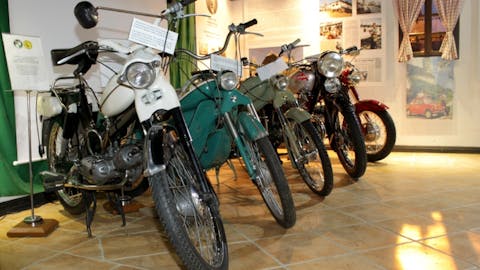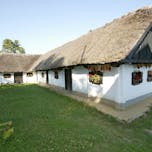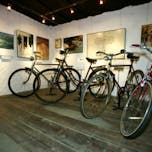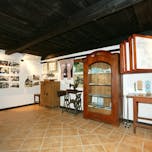
Puh’s cimprača with a memorial room dedicated to the world-famous inventor Janez Puh stands in his native village of Sakušak near Juršinci in the Slovenske gorice region. Through ethnological heritage, archival materials, and museum exhibits, his life and work in the field of means of transport and motor engineering are presented. Janez Puh was an inventor and visionary, an industrialist and entrepreneur. The Puh Museum is managed by the Janez Puh Homeland Association.
The Puh Museum is a cimprača — a traditional vintner’s cottage such as once existed — covered with straw and with small windows. The main rooms of the cottage, especially the kitchen and the hiša (living room), are furnished and display numerous ethnological objects: a hand mill, bread oven, carpenter’s chest, bohkov kot (sacred corner), and others. It reflects the era in which Janez Puh grew up and was educated. The cimprača strongly resembles the homestead where he was born. On the site of his original birthplace at Sakušak 79 now stands a modern residential house with a memorial plaque.



Janez Puh (1862–1914) trained as a locksmith and furthered his expertise in Austria and Germany, as well as during his military service in the artillery. In 1885, he settled permanently in Graz; while working for the masters Luschneider and Albl, he repaired uncomfortable and dangerous bicycles (called “mišolin”) and carried out design improvements. In 1889, Puh became independent, founded the company Styria Werke, and produced the bicycle named Styria. Despite fierce competition, between 1893 and 1895 the bicycle achieved excellent results at international races and won the famous Bordeaux–Paris ride.
In 1899, Werner and Puh bought an old mill in the southern part of Graz, where the first factory production of bicycles began, laying the foundation for the present-day Steyr-Daimler-Puch of Magna. In 1901, the first motorized bicycle with a gasoline engine came out of Puh’s factory. Although Puh did not invent the bicycle itself as a vehicle, he perfected vehicles through his inventions and patents; 19 of his patents are known today.
The exhibits in Puh’s memorial room were taken from the exhibition of the Historical Archive in Ptuj entitled Janez Puh, Johann Puch, the Man Who Turned the World Upside Down, authored by Mag. Kristina Šamperl Purg and staged in 1999 at Domino in Ptuj. These include photographs and various documents, plans, posters, and more. Displayed are also a two-cylinder motorcycle from 1906, two men’s bicycles by Puh from before World War I and from 1911, two women’s bicycles from before World War II, and others.
The cimprača (traditional cottage) housing Puh’s memorial room has burned down twice (in 2000 and 2004). Thanks to voluntary work by members of the Janez Puh Homeland Association and the help of donors, the entire museum was rebuilt (2005); the association also has its premises in the cellar. The association has around 300 members from 38 Slovenian municipalities and boasts a large number of vintage motorcycles and automobiles. In addition to managing and promoting the Puh Museum, it has set itself the task of presenting technical heritage to the wider public.

